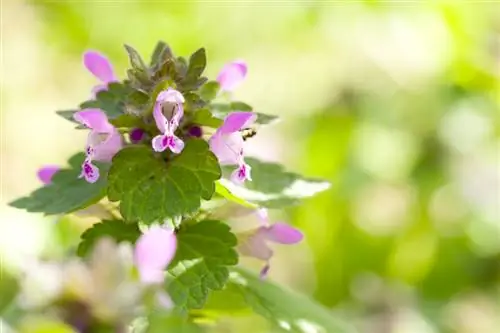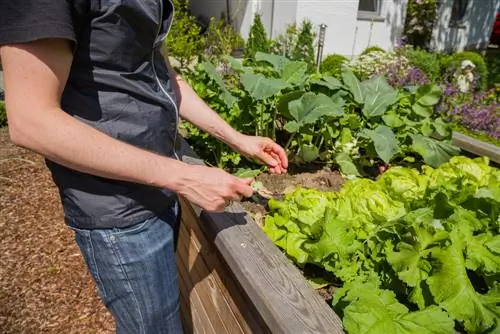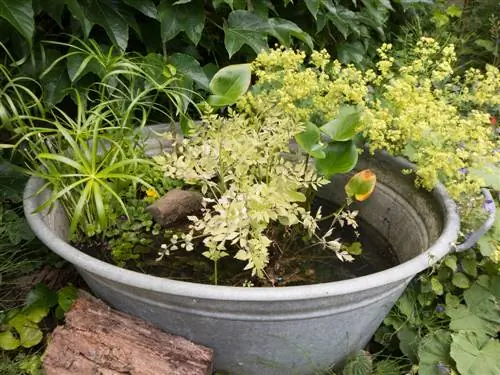- Author admin [email protected].
- Public 2023-12-25 17:45.
- Last modified 2025-01-23 11:22.
The deadnettle won't let you down in precarious garden locations. The distinctive wild perennial decorates the low-light shade bed as a solitary plant and ground cover with colorful flowers and beautiful foliage. If you still have questions about cultivation in your head, find a practical answer here.

What characterizes deadnettle as a garden plant?
The deadnettle is a distinctive wild perennial that thrives in partially shaded to shady locations and delights with colorful flowers and beautiful foliage. Easy to care for and undemanding, it only requires occasional watering and fertilization as well as light winter protection in the planter.
Planting deadnettle correctly
So that the valuable wild perennial develops its powerful growth right from the start in the garden, pay attention to the following aspects when planting:
- Put the still potted root ball in water
- Dig a pit in a semi-shady to shady location with twice the circumference of the root ball
- Mix the excavated soil with compost (€12.00 on Amazon) and horn shavings
- Plant the potted deadnettle up to the bottom pair of leaves and water it
Planting in the pot is similar, with a few pieces of pottery or pebbles inserted under the substrate as drainage.
Care tips
To list all the factors involved in caring for a deadnettle, the fingers of one hand are enough. How to do it right:
- Watering in summer drought
- Fertilize organically if necessary from April to August
- Cut off wilted flowers straight away, leave the leaves in early spring
- Light winter protection only required in the planter
If there are no flowers in the first year, you have still done everything right. The majority of deadnettle species and varieties only bloom from the second or third year onwards.
Which location is suitable?
In the wild, the deadnettle is an assertive pioneer plant. Wherever it is not exposed to direct sunlight, the colorful flowers shine towards us. Plant the ornamental plant in the garden in these locations:
- Partially shaded to shady location
- Loose garden soil, humus and rich in nutrients
- Preferably sandy-loamy to fresh-moist, without risk of waterlogging
Deadnettles are therefore the ideal candidates for greening a bed with little light under the dense canopy of tall trees. The sunnier the location, the wetter the location should be.
The correct planting distance
If the deadnettle acts as a ground cover in a partially shaded bed or under deciduous trees, plant the plants at a distance of 25 cm, or 16 specimens per square meter. The noble wild perennials with a growth height of up to 60 cm, set decorative accents as solitary plants in low-light locations when planted at a distance of 45 cm, or 4 specimens per square meter.
What soil does the plant need?
The dead nettle develops its rapid growth preferably in nutrient-rich soil that is at the same time loose and fresh-moist in structure. Botanists therefore classify the plant as an indicator of freshness and nitrogen. The wild perennial proves to be tolerant of soil acidity as long as it is not confronted with an overly acidic or strongly alkaline pH value. In the pot, the popular bumblebee willow is content with commercially available compost-based potting soil.
What is the best time to plant?
Plants grown in containers can be planted throughout the entire growing season. Give dead nettles ideal starting conditions for plant life by planting the young plants in the ground between mid-May and mid-June.
When is flowering time?
The selected variety defines the flowering period of a deadnettle. While the wild species bloom for what feels like an eternity from April to October, hybrids usually present their flowers from May to July. The breeds make up for the shorter flowering period with decorative attributes, such as a magnificent foliage pattern.read more
Cut dead nettle correctly
In a natural garden, pruning dead nettles is not necessarily an indispensable care measure. Give the wintergreen mint a free hand, it will grow independently and shed its leaves shortly before the new shoots in spring. If you do not want to sow yourself and are bothered by the appearance of the withered leaves, cut the ornamental plant like this:
- After flowering, cut off the withered heads before the seed heads develop
- Cut off the wintergreen leaves close to the ground in February/March as soon as the leaves have grown in
Watering deadnettle
Under normal weather conditions, a deadnettle is content with the natural rainfall. Watering is only carried out when drought persists. In pot culture, however, there is a need for regular watering. Check the substrate with your thumb every 2-3 days to water when the soil surface is dry. The perennial is content with normal tap water.
Fertilize deadnettle properly
The dead nettle has a vital growth potential that does not require additional nutrients in classic garden soil. However, if deficiency symptoms appear, such as limp leaves and stunted flowers, add a portion of compost or horse manure every 3-4 weeks from April to August. In the limited substrate volume of the balcony box or pot, apply a liquid fertilizer every 4 weeks during the summer.
Wintering
The deadnettle is completely hardy. Even temperatures of -30 degrees Celsius do not cause any problems for the flower. Instead, the wintergreen species and varieties decorate the garden during the cold season. Therefore, only cut the plant close to the ground in early spring to create space for the next shoot. Only the withered inflorescences are cut off in autumn if self-sowing is not desired. If you cultivate the dead nettles in the planter, the root ball could freeze through. Wrap a bucket or balcony box with bubble wrap and place it on wood or Styrofoam.
Propagate deadnettle
The majority of deadnettle species display a vital urge to reproduce. They colonize the bed within a short time using self-sowing and root runners. If you would like to decide for yourself where you are going, you can choose from the following methods:
- Dividing the root ball in autumn
- Separation of root runners
- Using non-flowering shoots as cuttings in summer
- Sowing the seeds directly into the bed between March and June
How do I transplant correctly?
If the previous location of a deadnettle subsequently turns out to be unsuitable, transplanting it is very easy. In early spring or better after flowering in autumn, dig up the root ball. Runners that are too long can be cut off with a spade beforehand. At the new location, place the nettle in the soil prepared with compost, maintaining the previous planting depth and water generously. Do not cut the flower back completely yet so that the foliage can act as natural winter protection. The root runners that remain in the ground at the previous location should be completely removed, as the plant will sprout from them again.
Deadnettle in a pot
With rustic charm, the dead nettle in a pot adorns partially shaded and shady corners on the balcony or terrace. Don't choose a pot size that is too small if you choose one of the tall-growing noble varieties. Drainage made of grit or expanded clay above the water drain in the floor prevents harmful waterlogging. Common potting soil meets the requirements as a substrate. How to properly care for the decorative leaf plant:
- Watering regularly with normal tap water
- Fertilize liquidly every 4 weeks from April to August
- Cut off the heads after flowering so that the seeds don't fly around in the garden
- Pruning close to the ground only takes place in early spring
If winter is just around the corner, cover the pot with bubble wrap and place a block of wood under it. Pots with a diameter of less than 30 cm move to a bright, frost-free winter quarters. Continue watering when the substrate dries out. There will be no fertilization until March.
Is dead nettle poisonous?
The deadnettle is by no means poisonous. On the contrary, the mint family has made a name for itself as a medicinal plant and food. Prepared as a tea, the flowers relieve a wide range of he alth problems. Small children are crazy about sucking the sweet nectar from the deadnettle flowers. Harvest the delicate flowers shortly before the flowering period begins to cook a delicious, he althy vegetable that is reminiscent of spinach.read more
Deadnettle not blooming
Don't be surprised if a deadnettle doesn't bloom in the first year. The vast majority of all species and varieties only develop their first flowers in the garden in the second or third year. Until then, the plant will develop a sufficient amount of leaves that have enough potential to supply the flowers.
How do I make a tea from deadnettle flowers?
Deadnettle flowers have natural healing powers against a wide variety of ailments. Prepared as tea, they relieve, among other things, bladder problems, intestinal problems, coughs and insomnia. For skin injuries or minor burns, washing with dead nettle flower tea promises rapid healing. How to harvest the flowers and prepare the tea:
- Cut off the deadnettle flowers in summer before seeds begin to form
- Pour 250 ml of boiling water over 2 teaspoons of fresh or dried flowers
- Let it steep for 15 minutes and strain
If the plants come from organic cultivation in a hobby garden, give your children the flowers to suck. The little ones will love the sweet taste of the nectar.read more
How do I distinguish dead nettles from stinging nettles?
Of course you can boldly dig into the leaves to determine the difference. However, it is less painful to pay attention to the visual distinguishing features. Look for the white, brown-red, pink or yellow deadnettle flowers. Stinging nettles don't bloom that beautifully. Their flowers are tiny and greenish.read more
Beautiful varieties
- White Nancy: Premium variety with green-edged, silvery shimmering leaves and white flowers; Growth height 15 cm
- Elisabeth de Haas: Beautiful spotted deadnettle boasting purple-violet flowers; Growth height 15-20 cm
- Pink Pewter: A striking silver-leaf deadnettle that adds a splash of light pink color to the shade bed; Growth height 15 cm
- Nessel King: The large-flowered deadnettle impresses with its elegant silhouette and brown-red flowers; Growth height 40-60 cm
- Goldennettle: A royal variety with golden yellow flowers and oval, tapering leaves with a serrated edge; Growth height 20-30 cm
- Red Nancy: Great problem solver for shady, dry locations with slightly acidic soil; Growth height 15-20 cm






